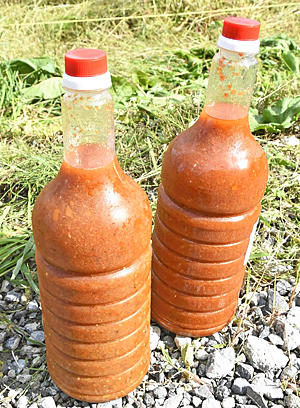Village battles wild boars with habanero pepper concoction to protect crops(『劇辛ハバネロ』イノシシには辛い?)

Would a local product be useful in protecting crops from wild boars in a particular region?
The Michi-no-Eki Hirata roadside station and Fukushima University are jointly conducting an experiment in the village of Hirata, Fukushima Prefecture, to see if habanero pepper (see clip) -- a locally grown chili pepper -- is effective in warding off wild boars.
The project has sparked expectations among area farmers.
道の駅ひらた(平田村)と福島大は27日、トウガラシの一種で村特産のハバネロがイノシシよけに効果があるのかを確かめる実証実験を村内で始めた。特産品の「激辛」食材はイノシシから農作物を守ることができるのか。地元の農業関係者から熱い視線が注がれている。
The experiment began on Sept. 27 at four locations in the village when the research team spread a liquid concentrate form of habanero, as well as a concoction featuring wood vinegar and habanero, around a number of fields.
The team then installed a camera with a sensor and is spreading the two concoctions on regular basis to determine their level of performance. It will look at the best times to spread and the effectiveness by monitoring the area's wild boars, animals that have a tendency to sniff the ground as they move along.
実験は村内4カ所の畑で始まった。この日は畑の周りにハバネロの濃縮液と、濃縮液に木酢液を混ぜた液体を散布。センサー付きのカメラを設置した。
今後は定期的に液体を散布。映像で地面の匂いをかぎながら移動する習性を持つイノシシの反応を見て効果を確かめ、イノシシよけとしての特徴や有効な散布のタイミングを検証する。
The concentrated liquid combines 80 liters of water and 20 kilograms of habanero. The mixture is then boiled down to about 20 liters.
According to a village official overseeing the experiment, between 300 and 400 wild boars are captured in the village annually, and the damage to agriculture is increasing year by year. Farmers are looking at the use of the spicy liquid to protect their crops.
濃縮液は水80リットルにハバネロ20キロを入れ、約20リットルになるまで煮詰めて作られている。実験に参加した村の担当者によると、村内でイノシシは毎年300~400頭が捕獲されているが、農作物の被害は年々増えており、激辛食材への農業関係者の期待は高まる。
The roadside station sells habanero soft-serve ice cream as well as curry, with the aim of boasting to be "the spiciest village in Japan." The station manager Tetsuya Kono came up with the idea to use habanero peppers to thwart wild boars.
Many habanero peppers often grow misshapen, and those not fit for sale had long been immediately thrown out on the fields. Farmers ultimately realized that crops in the fields where habanero had been tossed aside didn't experience damage from wild boars.
Kono then developed the habanero liquid and distributed some to neighboring farmers, who used it in their fields and found it "seemed to be working."
To prove this notion, the team asked Fukushima University Associate Prof. Shota Mochizuki of the food and agriculture sciences department specializing in animal damage to collaborate on the experiment.
道の駅ひらたは「日本一辛い村」を目標に掲げ、ハバネロを使ったソフトクリームやカレーで人気を集めている。高野哲也駅長がハバネロをイノシシよけに活用する構想を始めたのは昨秋。
ハバネロは形が整わないなどの規格外品が多く、規格外となった実は畑に捨てられていたが、生産者が捨てられた実の周辺ではイノシシの被害がなかったことに気付いたという。
高野駅長が試しに濃縮液を作り、農家に配って畑にまいてもらうと「どうやら効いているようだった」。裏付けを得るため、獣害問題に取り組んでいる福島大食農学類の望月翔太准教授に協力を仰ぎ、実験開始につながった。
According to Mochizuki, chili peppers are already in use in warding off wild boars in Japan, and habanero is expected to have a certain effect. However, wild boars are smart, and its effect would be temporary, he said, just like when electric fences were installed: Boars eventually can adjust to the stimulation from the current, and the same result could be expected in this case with habanero.
"Using habanero alone would be present difficulties," Mochizuki said. "[By avoiding habanero], boars would be exposed to electric current less often. As a result, they wouldn't be able to adjust to [those kinds of gimmicks]."
望月准教授によると、国内でトウガラシを使ったイノシシよけは行われておりハバネロにも一定の効き目が予想される。しかしイノシシは学習能力が高い。電気柵を設置しても、いずれは電流の刺激に慣れて通り抜けるように、効果は一時的になるとみられる。
望月准教授は「ハバネロだけでは難しい」とし、「イノシシが(ハバネロを避けることで)電気柵に触れる回数を減らし、慣れないようにできる」と二重の対策による効果を期待する。
Mochizuki also had high praise for the idea to use a local product: "It's good for things to the produced abd consumed in the same area."
The experiment will run through the end of the year, and the roadside station plans to commercialize the habanero liquid if testing goes well.
また望月准教授は特産品を使うことについて「地元で作ったものを地元で還元する。良い取り組みになる」と強調する。実験は年内行う予定で、道の駅ひらたは結果を受けてから商品化も視野に取り組みを進める。
◇
Habanero pepper Chili peppers are originally from Mexico and are known for being extra spicy. They are rated 100,000 to 350,000 on the Scoville scale (a measurement of the pungency), much higher than the 40,000 to 50,000 Scoville of chili peppers cultivated in Japan. The village of Hirata, Fukushima Prefecture, shipped 1.5 tons of habanero in 2019 and aims to ship about 2 tons this year.
( Translated by The Japan News )
ハバネロ メキシコ原産のトウガラシで激辛の香辛料として知られる。トウガラシの辛さを示す数値である「スコビル値」は10万~35万スコビルと、国産トウガラシの4万~5万スコビルを大きく上回る。平田村では昨年1.5トンを出荷し、今年の出荷量は約2トンを目標としている。
【 2020年9月28日付・福島民友新聞掲載 】
- Futaba Post Office reopens after 13 years(双葉郵便局、13年ぶりに再開)
- Craft sake brewery to make unmanned station more welcoming(無人駅の「クラフトサケ」醸造所がお出迎え)
- New Kitakata ramen developed to appeal to foreign tourists(訪日客向けの喜多方ラーメン開発)
- Aizu-Wakamatsu students come together with teahouse project(会津若松の生徒、茶室プロジェクトに集結)
- New hotel to be symbol of reconstruction(復興のシンボルとなる新ホテル)
- Radiation-resistant cameras to be produced in Fukushima(耐放射線カメラ、福島県で生産へ)
- International flights to Fukushima to resume after 13-year hiatus(福島の国際定期便、13年ぶり再開へ)
- Fukushima association to create base for parents of children with disabilities(障害児の親へ拠点作り)
- Real shell mound from Jomon period goes on display in Minami-Soma(南相馬で縄文のリアル貝塚展示)
- Japanese man opens restaurant to provide free meals to residents of war-hit Ukraine city(日本人男性が戦禍のウクライナに無料レストラン開店)